
Building a Brand Story: How to Do It Right
Your brand is speaking even if you haven’t said a word. Do you know what it’s saying? It’s telling a story of who you are and what you stand for. This brand perception could be good—or it could be detrimental. It depends on what the story is.
The good news is that you can control this brand perception. The bad news is that if you do not have a brand story, you’re not controlling anything (regardless of how many product images you post on Instagram).
Furthermore, without a brand story, you will miss out on connecting with the people who can align with your brand’s purpose and mission and become loyal ambassadors. These people will be able to tell the story of your brand better than you ever could, resulting in automatic word-of-mouth marketing and increased revenue.
Today’s consumers aren't just buying your products. They’re buying your brand and what you represent (your story). The key lies in building a brand story—one that your customers will never want to put down.
What Is Your Brand Story and Why Do You Need One?
Stories are what unite us and compel us to take action.
They can get our blood pumping and before we know it, we are emotionally invested in what happens to the hero of the story.
Why are stories so compelling?
Stories evoke emotion and get our hearts involved, which breeds connection. A brand that can connect to its customers on a heart level is a brand that will enjoy loyal customers for life. Empathy breeds trust, and trust forms strong, lasting connections.
Stories also have the unique ability to humanize brands and attract brand advocates who will not just buy from you but also fight for you, share your brand, and become one of your team. Your story can become a part of your audience’s identity and personal mission. When it comes time to buy what you sell, they will turn to you first instead of your competitors.
This is why building a brand story is so important.
Here’s the thing…
Today’s consumers are inundated with brands selling the same products for the same prices. Your story is one of the things that differentiates you from everyone else. It must be unique to every other brand selling the same thing.
As reported by Shopify, “Effective branding will either convince a customer to buy from you or from your competition,” says Cassandra Rosen, branding expert and cofounder at FK Interactive, a brand development and public relations agency. “If they’ve never purchased from you before, branding and narrative is what will prompt them to take a chance on your brand.”
As an example, the jewelry brand Pura Vida built a successful business selling bracelets and rings. Bracelets and rings? Nothing new here. Just pull up any major shopping outlet and you can find millions of them. So why is Pura VIda so successful? The brand did a great job defining and sharing its story, one that resonated with customers and made them proud to not only buy but also become a partner with Pura Vida’s mission.
Your brand is telling a story whether you want it to or not. The question is, “Which story are you telling?” If you don’t know, let’s talk more about building a brand story that captivates and connects.
Building a Brand Story Your Audience Will Never Want to Put Down
A compelling, authentic brand story articulates why you are in business and what drives you—your mission and values.
Essentially, your brand story reveals your WHY. Why do you do what you do? Why did you start your business?
If you are having trouble figuring out your “why,” answer these questions:
- Why did you start your business or organization in the first place?
- What story are you inviting your customers into?
- If they enter your story and engage with your brand, what are they accomplishing?
- If they enter your story and engage with your brand, where will it take them?
- What’s at stake if your mission or purpose is not fulfilled?
- What’s at stake for your customer if they don’t help fulfill the mission and purpose of your brand?
- What is the one thing that differentiates you from all of your competitors?
When you start to unpack these questions, you begin building a brand story—one that can be fined-tuned to intrigue your customer.
In order for a brand story to be captivating, it needs to open up possibilities and outcomes for your customer. Like any good story, something must be gained—and something is always at stake.
Answering these questions involves more than just jotting down your product features and benefits. (If this is your story, be prepared to have people fall asleep…)
How to Discover Your WHY
As just mentioned, one of the most important components of a brand story is your WHY. In other words, why did you start your business?
Did you have a passion for the product you created? Did you see a need in the market (you had yourself) and wanted to solve the problem? Did you want to create awareness around a social issue?
Take out a piece of paper (or a computer doc) and start writing/typing. Think back to when you started your company and write everything that comes to mind.
This is not the time to wax poetic. It doesn’t have to be perfect. But, it does need to be raw and emotional. Pull back the corporate facade and dig deep. Why did you get into your business in the first place?
If you’re getting stuck, it can be helpful to think about your brand story’s theme.
Your Brand Story’s Theme
Although brand stories are all unique (and should be), most will typically include one or more of the below themes (examples added):
- Rags to riches – You were once in poverty and have now built a successful business. Any transformational story is compelling. If you overcame odds (small or large) to build your business, let your audience know.
- Social awareness – You want to bring awareness of the growing hunger epidemic.
- Charitable giving and social good – Proceeds of your profits or products will go to charity.
- Love and dedication – You created a product line free of chemicals for babies because of your love for keeping children safe and healthy.
- Meets an industry need – Your volumizing shampoo doesn’t dry out your hair like others and it is also vegan and good for the environment.
- Improves lives – Your grocery delivery service assists those people who can’t leave their house and gives them back the gift of time.
If you’re having trouble building a brand story, think about which theme above resonates with you. At a minimum, your brand should have a unique differentiator—something that makes you stand out from the competition. This is just good business. In this case, your brand story can focus on meeting an industry need and solving a unique problem.
To inspire you, let’s take a look at two real-world examples of brands telling their stories…
The shoe and apparel brand Zappos is known for excellent customer service and free expedited shipping, a unique market differentiator. On Zappos’ About page, the brand talks about its origin story, which shows how it meets an industry need:
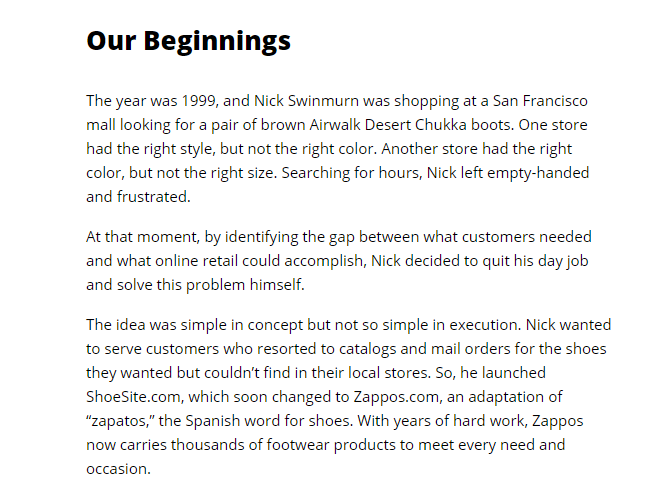
The Honest Company’s Our Story page shows a picture of its founder, Jessica Alba, with her kids. The brand started because Alba identified a need in the market she wanted to meet. Notice how the combination of image and copy reveals a more personal side to the brand and humanizes it, allowing the brand’s target audience (parents) to connect with its vision and values.
Something else to note… The quote below the picture positions The Honest Company as someone who has done the hard work for the parent. Now Jessica Alba is passing on the fruits of her hard work to parents everywhere so they don’t have to. The brand uses verbiage such as the following:
- “…you shouldn’t have to choose between what works and what’s good for you.”
- “We’re a wellness brand empowering people to live happy…”
- “…our founder couldn’t find one brand to trust… she had to create it.”
As I read this, I see a story unfolding. If I wasn’t thinking about how products in my home impact my family before, I am now!
The Honest Company gives parents the gift of having the best of both worlds for their kids. This cuts to the heart of every parent, compelling them to at least begin engaging with the company’s website.
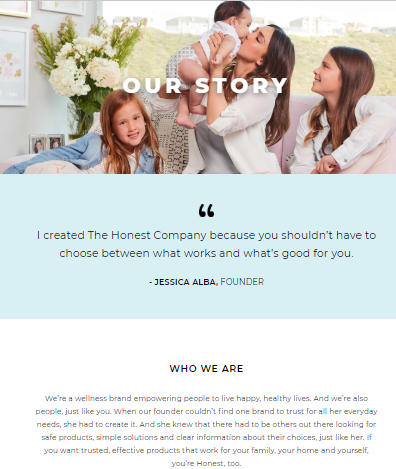
Help! I Don’t Have an Interesting Backstory!
Don’t have a compelling backstory? That’s okay. It’s not about who has the best story; it’s about honesty, transparency, and who can communicate that in a compelling way.
What do you stand for? What are your values? Even if you didn’t have a transformational business experience, you do have a unique personality, value set, and core beliefs. These also make up your brand story.
In addition to its unique differentiators, Zappos details its core values (kindness, inclusion, compassion) and what it focuses on internally and externally.
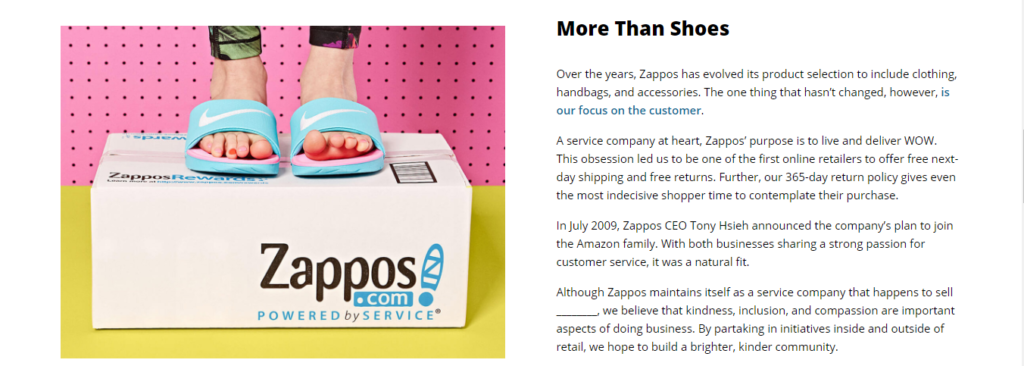
Not as big as Zappos? Neither was Zappos! The great thing about brand stories is that they can help small businesses compete with the big brands. Loyalty wins every time.
The e-commerce brand ELF has a mission to create timeless, handcrafted leather goods. To establish a connection with its audience, ELF’s About page (brand story) shows its craftsmen creating the shoes along with a video of how they treat their workers and practice fair trade production, one of the brand’s core values.
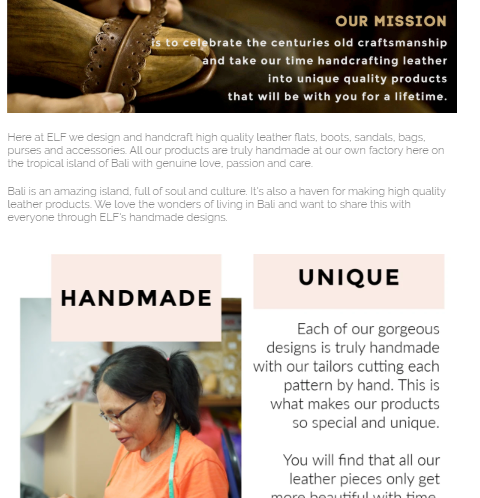
You can find leather shoes on every shoe shelf in the world, and ELF’s shoes are not cheap. So why wouldn’t people just buy a cheaper shoe somewhere else? ELF has become a successful brand because its customers align with the brand’s mission and have become loyal. This is the power of brand stories.
Even if you don’t feel like you have a brand story, trust us, you do! Maybe you started your business because you wanted to earn money (most people do), and you didn’t have any epiphanies or charitable causes. It’s not just about charity, although we are always on board with giving back!
Making money is typically the motivation behind starting a business, but it always goes deeper. You have convictions and values you live by, and if you are passionate about your business, those values will shine through. So if you feel stuck building a brand story, focus on your values and your company’s purpose.
You can even talk about stories from your business’ early days, the rough times, some of the mistakes you made, the wins and losses. These are honest stories that humanize your brand—and they can become a part of your brand story.
Now, we're not saying to air all of your dirty laundry for everyone to see. Just let potential customers see the person (or people) behind the brand. People can’t connect with entities—they connect with other people. If they can connect with you, trust you, and agree with your mission, they will become loyal customers.
Don’t sweat the small stuff…
The key here is not to get bogged down with the details. You’re not writing ad copy—yet. Just remember that the purpose of building a brand story is to humanize your brand and allow your audience to connect with the person behind the “corporate” facade.
- At the end of the day, an effective and compelling brand story should display…Empathy toward your customer’s problem
- How you are the one they can trust to lead them through their problem
- How you’ve overcome your customer’s problem and want to share this wisdom with them
- Your leadership and credibility
- The ways in which you’re different from your competition
- Your mission, purpose, and values
- Your personality and unique story of why you started your business (if you have one)
Once you figure out your WHY or your brand’s values and differentiators, it’s time to share your story. But first…
IMPORTANT: Alignment with Your Product and Audience
You can have the most compelling backstory in the world, but if it doesn’t align with your target audience and product, your brand will not grow. Successful brands build stories around the things their customers value because most were once part of that target market.
If you’ve been a loyal reader of the Viral Solutions blog, you know that we talk a LOT about knowing your audience and why it is so important for growing businesses. Knowing your audience is also essential when building a brand story. This is because your brand story MUST relate to both your product and your target audience.
Your brand story will not appeal to everyone—and this is good! It will only appeal to the people you are targeting. You can’t appeal to the masses. In doing so, you will appeal to no one because your product and audience will not be specific enough to capture a connection.
Here’s an example: Imagine that you wanted to sell eyeglasses online to every person who wears glasses. In an attempt to “be all things to all people,” you put up an online store and sell every style of glasses, appealing to all ages, at the same price points as local establishments.
What’s the problem with this?
- You have no unique differentiator. Why would people choose to buy glasses over the internet instead of visit their local establishments if there is no benefit to them?
- Who is your target? If you are targeting all age groups and types of people, your marketing will be vague and disconnected. How do you target all age groups at the same time? The answer is you can’t, so your advertising and brand story will fall flat.
- If you haven’t researched the market and your customer avatar, you may not realize that people are hesitant to buy glasses online because they want to try them on first.
Eyeglass company Warby Parker built a billion-dollar brand selling eyeglasses online. How? They did their market research and realized early on that consumers would need to try glasses on before buying them. They also found out that their target market wouldn’t pay the same prices online that they would locally.
Knowing their market, Warby Parker created a brand story that differentiated itself from its competition by offering stylish eyeglasses online at lower prices and allowing customers to try on five pairs at home for free. Warby Parker knew its audience’s pain points and solved them.
In addition, Warby Parker is a socially conscious brand that donates one pair of glasses for every pair sold. Check out the brand’s history and story:
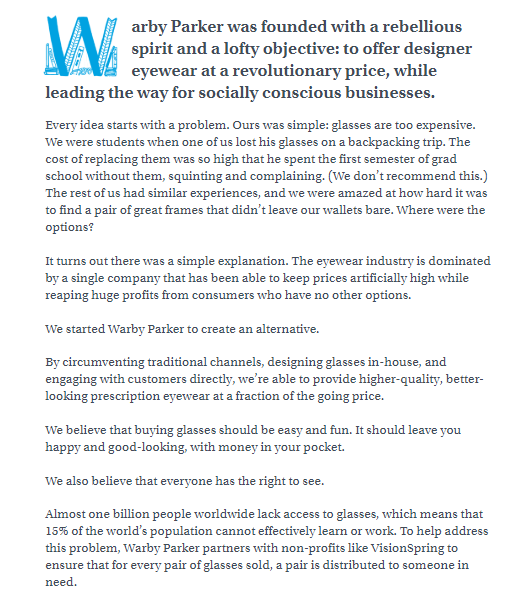
In summary, know your audience, their passions, their pain points, and their desires so you can ensure your product and brand story align.
If you need some help researching your target market, check out our free resources here:
Market Orientation & Research: Leaving the Darkness and Stepping into the Light – Part 1
Market Orientation & Research: Leaving the Darkness and Stepping into the Light – Part 2
How to Do Market Research: A Guide for Beginners
Building a Brand Story: What You Need to Know
In this article, we talked about what a brand story is, why it is important, and how to create one that aligns with your products and target market. In summary, remember these key tips if you want to craft a brand story that connects to your target customers and boosts your business:
- Your brand story is the one thing that differentiates you from everyone else.
- A brand story humanizes your brand so people can feel connected to you—the person (or people) behind the corporate persona. This increases sales and grows your business because people will want to become a part of your mission.
- A compelling and authentic brand story articulates why you are in business and what drives you.
- A brand story also includes your mission, values, and purpose.
- Building a brand story is not just telling your interesting backstory; it’s about authenticity and transparency, however that looks to you.
- To create an effective brand story, it must align with your target audience and products.
Need some assistance researching your market and crafting your unique brand story? We’d love to help. We value collaboration and teamwork and have been in business for nearly 10 years with 75+ years of collective sales and marketing experience. We never rely on guesswork; instead, we help brands get real data to create sound marketing strategies so they can win—and win big! Hint: this is part of our brand story 😉
If you'd like to hop on a call, schedule your free consultation right here.


